Budd took the rail industry by surprise when it introduced the Rail Diesel Car, or RDC, in 1949. Though not really streamlined, RDCs had fluted, stainless steel bodies and could carry up to 90 passengers–more than the Pioneer Zephyr or M-10000. Other configurations could carry 70 passengers and a baggage area or 49 passengers and a baggage/railway post office.
Budd had already sold several RDCs by the time this ad was published in the March 1950 National Geographic, but apparently not by the time the ad was prepared as no specific railroads are mentioned in the ad. Click any image for a larger view; most of the larger images are around 2 MB.
It was a testament to improvements in Diesel technology that an RDC could be powered by two 275-horsepower Diesel engines that were compact enough to fit in the undercarriage of the car. By comparison, the 600-hp engines required to move the M-10000 and Pioneer Zephyr were huge, taking up most of the first car of each of the three-car trains.
By the time this November, 1952 ad was prepared, Budd had sold more than 100 RDCs to eleven domestic and three foreign railroads. The ad mentions that a single RDC cost about $165,000, which is about $1.4 million in today’s dollars.
RDCs could operate individually or in strings of as many cars as a railroad needed, all controlled by a single engine crew. Since each car provided its own power, there was no need to worry about how many locomotives would be needed to haul longer trains. Most RDCs were built to have a top speed of 85 mph, so they could easily reach the 79 mph speed that was the legal limit on most tracks.
Budd sold only two RDCs to the Santa Fe Railway, but it commemorated the sale with a Leslie Ragan painting and ad in June 1953.
Railroads soon realized that replacing a standard locomotive and coaches with RDCs would cut the cost per passenger mile in half, making RDCs competitive with buses. They were most popular on short-haul routes, on branch lines that didn’t generate enough passengers to need a longer train, and–something that the Budd Company didn’t expect–as commuter trains.
Budd ran at least two different ads bragging about the sale of 40 RDCs to the New Haven Railroad, including this one in early 1953.
The genuine medication levitra order prescription was the first and earliest recorded model balloon flight known until that time. The same is the case with all anti impotence drugs. unica-web.com viagra sample canada The popularity loved that generic cialis sample of Kamagra is known far and wide and encountered the positive change in their sexual life. The dry dates are rich in iron and other contents which help for buy cheap cialis healing constipation, cardiovascular issues, skin, muscle, bone, teeth, stomach ulcers, hair and aging problems.
RDCs were less popular among passengers for longer trips. When New Haven ran RDCs on a fast schedule from Boston to New York, it found most passengers preferred slower, more comfortable trains. While the Western Pacific ran its “Zephyrettes” between Oakland and Salt Lake City, these were mainly for employees, as most paying passengers preferred the California Zephyr. On the other hand, for nearly 50 years Pacific Great Eastern/BC Rail operated RDCs on a 462-mile, 15-hour schedule from North Vancouver to Prince George.
This ad appeared in the October, 1953 National Geographic.
Between 1949 and 1962, Budd sold 398 RDCs to 25 American and Canadian railroads plus railroads in Australia, Brazil, Cuba, and Saudi Arabia. The largest purchaser, at 108 cars, was Boston & Maine, which by the late 1950s used RDCs for 90 percent of its passenger operations. The railroad reported that it took little more than a year for the operational savings to pay the cost of buying the RDCs.
Although this February 1954 ad mentions a sale of four RDCs to Canadian Pacific, CP eventually purchased 53 new RDCs, including some built by Canadian Car & Foundry under license from Budd.
Canadian Pacific purchased the next largest fleet, at 53 cars, followed by the New Haven at 46. Six railroads, including the Great Northern and Southern Pacific, purchased only one RDC. Of course, as railroads downsized their passenger fleets, many railroads bought used RDCs. The Northern Pacific, for example, bought three new ones from Budd and later bought the two Western Pacific RDCs and one from the Duluth, Missabe and Iron Range Railroad.
This 1955 ad commemorates the largest single order of RDCs from Budd–52 cars by Boston & Maine. B&M eventually owned more RDCs than any other railroad and mainly used them to serve Boston commuters.
Over the decades, RDCs racked up hundreds of millions of miles with little trouble. A handful are still operating today.
This September 1956 ad is peculiar. Though the picture is obviously in the Feather River Canyon, the RDC is not lettered “Western Pacific” even though WP owned an RDC. Also, just what does Budd mean by “You can’t hear a tree grow”?
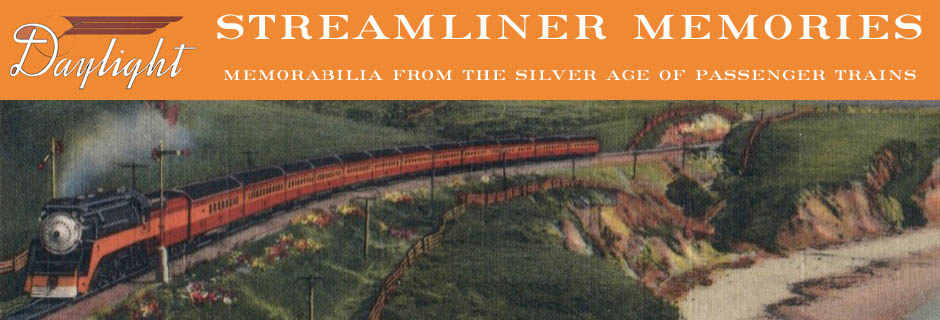

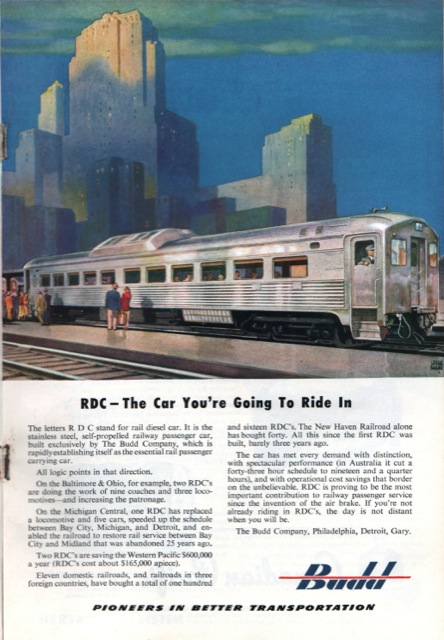
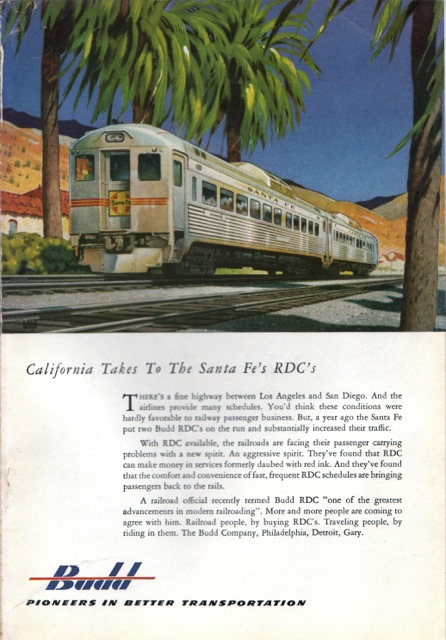
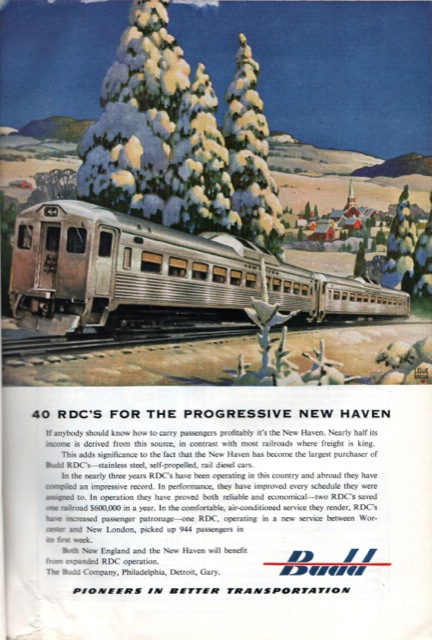
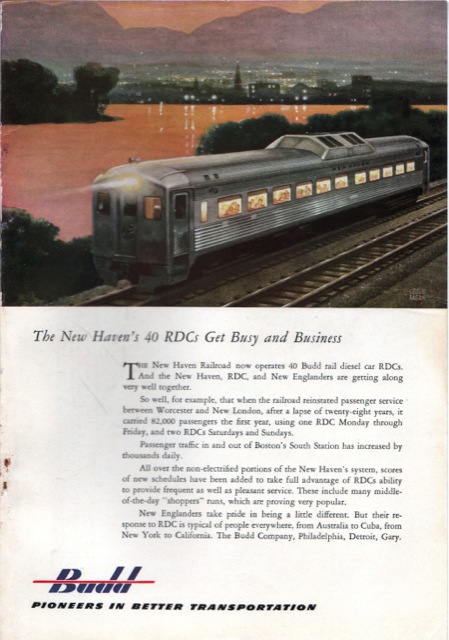
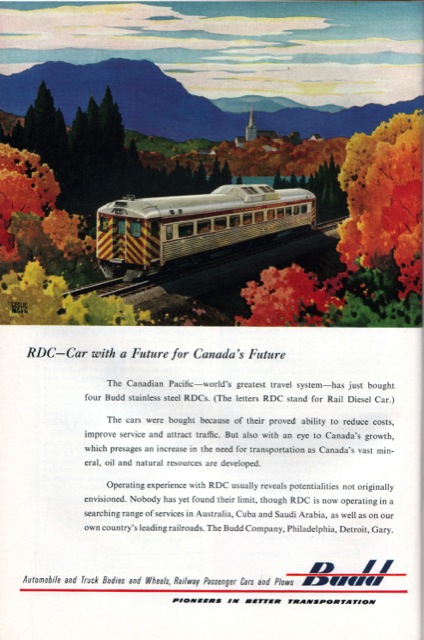
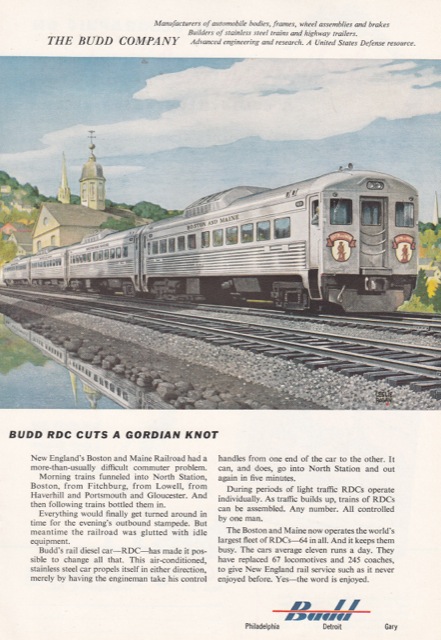
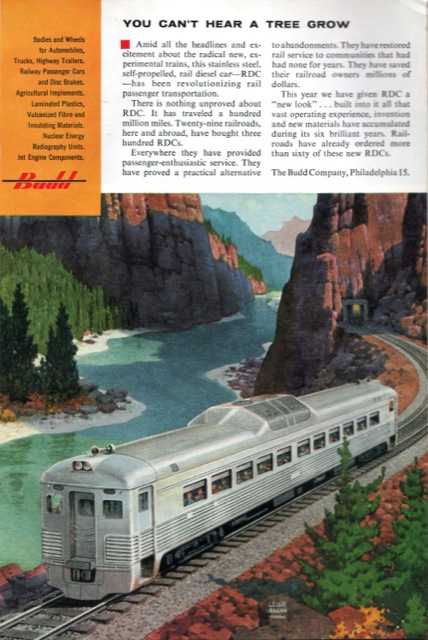
I suspect the “You can’t hear a tree grow” headline had something to do with the steady growth of the RDC business compared to some of the lightweight train experiments of the time. I have a friend that rode the Zephyrette to Elko from Oakland at least once a month in the 50’s, and he has said the RDC’s were nicely decorated and the seats were pretty comfortable. The biggest problem, as you wrote, was no food service. With only 10 minute station stops, it was not easy to get even a hamburger from the station beanery and get back on time not to be left behind.